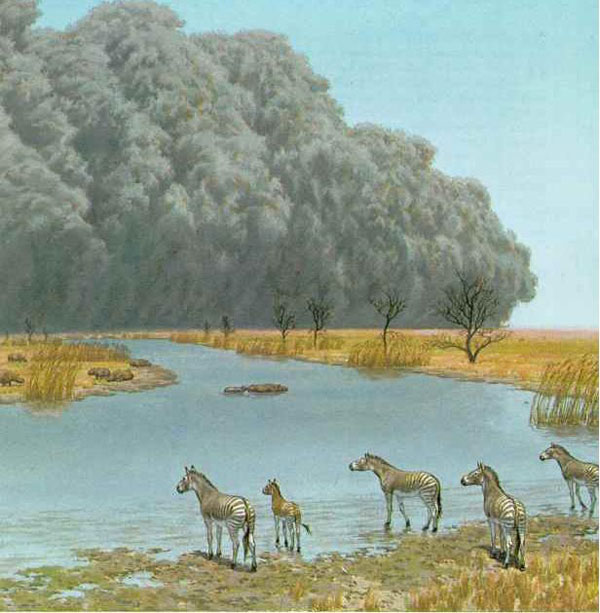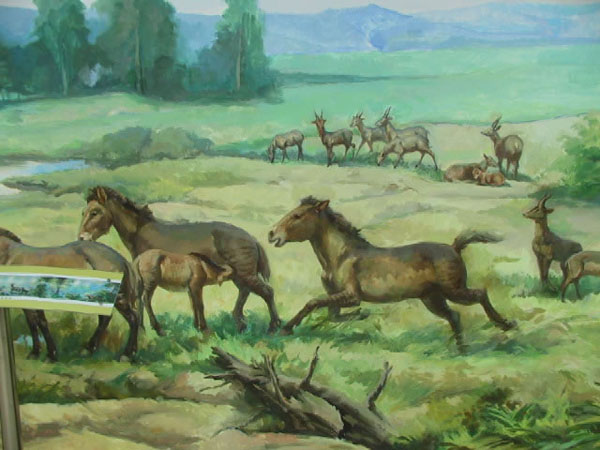The connection between horses and human history can be traced back 350 centuries. The earliest records come from wild horses in cave paintings from the Middle Paleolithic period in France and Spain, about 35,000 to 100,000 years ago. The history of human domestication of horses is later than the domestication of dogs. Domestic horses were domesticated about 6,000 years ago from the Taiban horses in Western Europe or the Przewalski's horses in East Asia. Since then, horses have played an extremely important role in human history.

Archaea
However, horses themselves have a much longer history. Horse fossils have always been regarded as the most typical example of biological evolution, because horses have preserved a rich fossil record during their 58 million years of geological history, and this record has continued to the well-known living horses. As early as 1851, Sir Owen of England recognized the linear evolutionary sequence from early horses to true horses. Their toes gradually changed from multiple toes to single, and they became more and more adept at running.
Archaeopteryx appeared in the earliest Eocene Epoch and was only the size of a small dog. The body of Archeopteryx is light and flexible, with 4 toes on the front feet and 3 toes on the hind feet. It has small hooves, but only 3 toes are functional on the front feet, so Archeopteryx is a strange-dactyl animal; its limbs are slender. , suitable for running, the wrists and ankles are lifted off the ground, so the position of the toe bones is almost vertical; its back is curved, its tail is short, and its long and low skull is quite primitive; its teeth are low-crowned, They have conical cusps, but the structure of premolars has not yet become similar to molars. Archeopteryx lived in tropical forests and swamps, feeding on young leaves on shrubs. During the Eocene Eocene, Archaeus was distributed in the Americas, Asia, and Europe. At that time, there were land bridges connecting these areas. The earliest discovered Archaeus materials came from the United Kingdom. Later, more well-preserved Archaeus were discovered in many areas of the western United States. specimen. With the end of the early Eocene, Eohorse became extinct in the Old World. Since then, the evolution of horses has been limited to the North American continent, and horses that later appeared on other continents spread from North America.

Three-toed horse restoration picture
During the Oligocene Epoch 40 million years ago, Oligocene horses appeared in North America, living in a dry climate and scrubby environment. The Oligocene horse is larger than Eohorse. Like a modern lamb, its back has become straight and hard, and the length of its legs has also increased. The little toe of its front foot has disappeared, so there are only three toes on both the front and rear feet. On the head, the middle toe is significantly enlarged, but all toes are in contact with the ground; its cheek teeth are still low-crowned, but except for the first premolar, the rest of the premolars have become the same as molars. This is the front The phenomenon of "molarization" of molars; the crowns of its cheek teeth form strong ridges, making them very effective tools for cutting leaves. The ancient steppe horse evolved from the Oligocene horse and lived during the Miocene period 18 million years ago. Its body has increased to the same size as a modern pony. The ancient steppe horse's front and rear feet still have three toes, but it only relies on the middle toe to walk, and the side toes on both sides have degenerated to the point where they are almost useless; its face has become longer, and its lower jaw has also increased; its teeth It has wear-resistant high-crowned teeth, making it easier to feed on widely distributed herbaceous plants.
The New Horse appeared about 5 million years ago during the Pliocene Epoch, and its size has grown to resemble a modern medium-sized horse. The Shangxin Horse is a progressive horse. The front and rear feet have become truly single-toed, walking with only the thick middle toe, and have well-developed hooves, while the side toes have degenerated to only traces, hidden in the skin of the upper part of the foot. ;The crowns of its cheek teeth become taller.
The real horse evolved from the New Horse about 4 million years ago, and its body shape is the same as that of the modern tall horse. Its limbs are highly specialized, the humerus and femur are short, the radius and tibia are long, the ulna and fibula are recessed, the only existing middle toe is well-developed, the metacarpals are very long, and the phalanges are relatively short; its cheek teeth have high crowns and enamel The folds are fine, and the first premolars have been reduced to very small sizes or even completely lost. True horses spread to other continents in the early Pleistocene and were widely distributed in Asia, Europe, Africa and South America during the Quaternary.
Horses have continued to change every aspect of their bodies over the course of 58 million years of evolution: they have grown larger and larger, their legs and feet have lengthened, their side toes have atrophied and their middle toes have strengthened, their backs have straightened and hardened; their premolars have become increasingly As they become more molar-like, the incisors become wider and the cheek teeth become taller, complicating the crown form; their skulls and mandibles become taller, their faces elongate, and their brains enlarge and become more complex.
Above we have told the evolutionary history of horses from Eohorse to true horses, but this is only a simplified main line. In fact, the evolution of horses is much more complicated. There are mountain horses and subhorses between Eozoan horse and Oligocene horse. The South American horse, which is distributed in South America, also evolved. The evolution of early horses was indeed relatively simple and linear. This phenomenon is called "linear evolution", and horses are often regarded as the most typical example of this kind of evolution. With the spread of grasslands in the Miocene, horses that adapted to feed on grass appeared under the influence of radiation. At the same time, horses that fed on young leaves continued to exist. Therefore, horses reached their greatest diversity in the Miocene. In the middle and late Tertiary Period, various offshoots of horses appeared. Some of their traits were progressive, while others were primitive. The two most important collateral branches in the evolution of horses, the angel horse and the three-toed horse, appeared in the Miocene. They are not the direct ancestors of the living true horses, but the fossils of these two genera are numerous and widely distributed. It has important scientific significance in comparing the strata of the Middle and Pliocene.
Angel horses are shaped like modern ponies and are animals that live in the forest. It was distributed in North America and Eurasia during the Miocene. Its teeth were low-crowned and it had three toes on both its front and rear feet.
The three-toed horse has a flexible structure and is similar in size to the angel horse. Of course, it is also three-toed, which is a primitive trait; unlike the angel horse, the three-toed horse's cheek teeth are high-crowned and have complex enamel. Wrinkles, this is a progressive trait. The three-toed horse was widely distributed in North America, Eurasia and Africa during the middle Pliocene Epoch, and it was not until the middle Pleistocene Epoch that it finally became extinct, leaving no descendants. In China, the three-toed horse is one of the most representative mammals from the late Miocene to the early Pleistocene.
South American horses are also an evolutionary side branch that appeared at the end of the Pliocene. They originated in South America when their ancestors entered the southern continent after the formation of the Isthmus of Panama. The South American horse was huge but had short legs and feet. It lived in the Pleistocene period and became extinct before the end of the Ice Age.
After experiencing vigorous evolutionary evolution and complex adaptive radiation, the history of horses returned to calm in the late Pleistocene. In the Americas, the main battlefield of equine evolution, horses completely disappeared 8,000 years ago. It was not until 1519 AD that Spanish colonists brought horses back to the American continent. Today, only one genus of Equus exists in the family Equidae, whereas in the Miocene there were at most 13 genera coexisting. All six wild species of modern horses are rare animals. They are three kinds of zebras (mountain zebra, plains zebra, fine zebra), two kinds of wild ass (African wild ass, Asian wild ass) and one kind of wild horse (Przewalski's zebra). Mustang).
animal tags: horse Eohorse fossil specimen Equidae
We created this article in conjunction with AI technology, then made sure it was fact-checked and edited by a Animals Top editor.